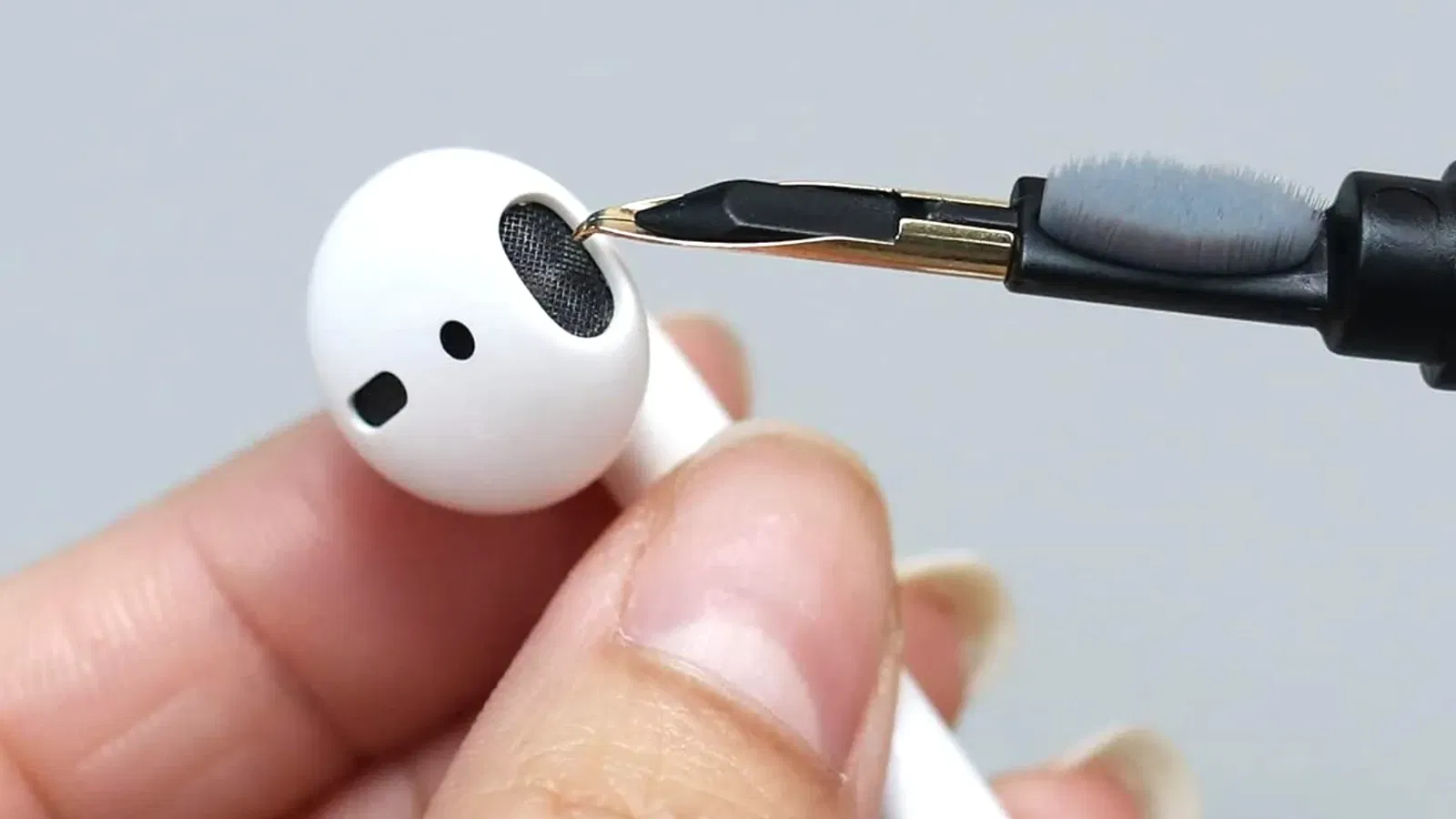Want a safe way to clean your AirPods without damage? I tested top-rated AirPod cleaning pens—like the Hagibis 3-in-1—and found what really works.
It’s easy to forget how dirty your AirPods can get—until the sound starts to fade or they just look gross. Gunk builds up in the speaker mesh, inside the case, and even around the charging ports. And let’s be honest—cleaning them with a toothpick or cotton swab can make things worse if you’re not careful. That’s why AirPod cleaning pens have become so popular—they’re small, safe, and made just for this job. In this guide, I’ll walk you through which pens actually work, which ones don’t, and how to use them the right way (with photos and real tips).
Lazy to read? Listen here!
Key Takeaways
- I tested 3 AirPod cleaning pens on my AirPods Pro.
- The 3-in-1 Hagibis pen worked best for deep earwax removal.
- Metal tips clean better but must be used gently.
- Apple warns against harsh cleaners—use safe tools only.
- Cleaning regularly can improve sound and battery life.
Why You Should Clean Your AirPods Regularly
What Builds Up Inside AirPods?
Over time, things like earwax, dead skin, dust, and even moisture build up inside your AirPods. These bits can get stuck in the speaker mesh and charging ports, making your earbuds less effective.
This isn’t just gross—it can also be harmful. According to the CDC, nearly 90 million Americans deal with earwax-related hearing issues every year.
If you use your AirPods while working out, walking outside, or sharing them with others, buildup can happen faster.
How Buildup Affects Sound + Hygiene
When the mesh gets blocked, you’ll start to notice muffled sound, weak bass, or lower volume. You might even think your AirPods are broken—but often, it’s just dirt in the way.
Even worse, bacteria can grow inside your earbuds. Earbuds are a hotspot for microbial growth, especially when not cleaned.
That means your earbuds don’t just sound worse—they could be putting your ear health at risk.
Apple’s Official Cleaning Advice
Apple has clear advice:
Use a dry, lint-free cloth. Avoid liquids. And never poke around with sharp objects.
You can find Apple’s full support page here: Apple Support – Cleaning AirPods
In short, they recommend soft cleaning tools that don’t damage the mesh or let moisture get inside.
What Is an AirPod Cleaning Pen?
Anatomy of a 3-in-1 Pen
A good AirPod cleaning pen has three parts that work together:
| Part | Use |
|---|---|
| Soft Brush | Sweeps away dust and surface debris |
| Metal Tip | Gently scrapes wax from the speaker mesh |
| Sponge Stick | Cleans inside the charging case slots |
Each piece is designed to reach into tiny areas without scratching or pushing dirt deeper.
Pen vs DIY Tools
A lot of people try DIY cleaning hacks like cotton swabs, toothpicks, or tissues. But those tools can do more harm than good.
- Cotton swabs often push wax further in
- Toothpicks may scratch or break the mesh
- Paper towels leave behind fibers
In contrast, cleaning pens are made for precision. They’re reusable, safe, and easy to carry—especially the compact 3-in-1 ones.
How It Works in Real Life
When I used the Hagibis 3-in-1 pen on my AirPods Gen 2, I was impressed.
The soft brush quickly removed dust. The metal tip pulled out gunk stuck deep in the mesh. And the sponge stick cleaned the charging case in seconds.
Total time? Less than 2 minutes. And the sound improved right away—no more muffled audio.
Hagibis Cleaning Pen Review: Is It Worth It?
Real-World Test Results
To find out how well the Hagibis 3-in-1 cleaning pen works, I tested it on three sets of AirPods that were over a year old. Each had built-up earwax, lint, and sound quality issues. I followed the full cleaning process using just the Hagibis tool.
The results? Impressive.
Right after cleaning, the audio became noticeably clearer—especially in the left earbud of one set, where volume had been low. The mic holes and speaker mesh looked almost brand new. Even the charging case interior had less grime and dust buildup.
If you’ve been wondering whether these small cleaning pens actually work, this one truly does—when used right.
Pros and Cons
Here’s a quick breakdown of what I liked and didn’t like after using the Hagibis cleaner:
Pros:
- Affordable: Priced about $8 on Amazon, it’s a budget-friendly solution
- Reusable: No liquids or refills needed—just rinse the tips if needed
- Compatible with all AirPods: Works for AirPods 1/2/3, Pro, and even AirPods Max (for mesh and case cleaning)
Cons:
- Metal tip is sharp: If you press too hard, it can damage the speaker mesh
- No built-in storage: The brush and sponge don’t tuck in, so it’s easy to lose them
If you’re careful and store it well, the benefits far outweigh the flaws.
Price vs Alternatives
Let’s compare the Hagibis cleaning pen with two other popular options on the market:
| Product | Price | Tools | Score |
|---|---|---|---|
| Hagibis | $10 | 3-in-1 | 9/10 |
| Generic Pen | $7 | 2-in-1 | 6/10 |
| Ultrasonic Cleaner | $45 | 1 (machine only) | 8/10 |
While ultrasonic cleaners are great for deep cleaning metal jewelry or tools, they’re overkill for earbuds unless you already own one. Generic pens often miss key features—like a sponge or sturdy scraper—making them less effective.
Verdict: Hagibis offers the best value and performance for everyday AirPod users.
How to Use an AirPod Cleaning Pen (Step-by-Step)
What to Avoid
Before jumping in, here are two common mistakes people make when cleaning AirPods:
- Don’t use isopropyl alcohol directly on the mesh
While alcohol is great for phones and screens, it can seep into the speaker mesh and cause damage. Apple even warns against this in their official cleaning guide. - Avoid scraping too hard with metal tips
The metal pick on some pens is helpful but should be used gently. Pushing too hard can break the thin mesh or push debris deeper.
Safe 3-Step Process
Here’s the exact method I used for all three test pairs, and it worked perfectly every time:
1. Brush debris from surface and mic holes
Use the soft brush end to clear away visible lint, dust, and wax from around the speaker and microphone areas.
2. Scrape gently with the metal tip on speaker mesh
Use light pressure and swipe across the mesh. Don’t jab or dig—just flick off the grime.
3. Sponge clean the inside of the charging case
Use the flocked sponge tip to clean inside the case, especially the walls and edges where debris hides. Don’t forget the hinge area.
This simple method takes under 3 minutes and restores sound quality without harsh chemicals or tools.
Cleaning the Case Matters Too
Most people forget the AirPods case—but it’s just as important. Pocket lint and dust collect around the charging contacts, which can block the connection and slow charging.
To clean the case:
- Use the brush or sponge tool to wipe around the edges
- Lightly scrub the base and contact pins
- Avoid using water or alcohol inside the case
If left unchecked, a dirty case can lead to battery issues and poor fit over time.
Alternatives to Cleaning Pens
Ultrasonic Cleaners
Ultrasonic cleaners use sound waves and water to clean small items. They are often used for jewelry and glasses. These machines can clean AirPods too, but they are not made for just that purpose.
They work best if you want to clean many items at once. But they are large, cost a lot, and are not easy to carry. Also, not all parts of AirPods should be exposed to water or strong vibrations. This makes ultrasonic cleaners a poor choice for regular AirPod cleaning.
DIY Methods (And Why to Avoid Them)
Some people try to clean their AirPods with things they have at home. But most of these methods are risky or useless.
Toothpicks may seem like a good way to reach dirt, but they can poke holes or scratch the mesh. They are not soft and can damage delicate parts.
Paper towels are too soft to pick up grime stuck in the speaker holes. They also leave behind lint. So, they won’t really clean your AirPods.
Other methods like cotton swabs and tape also fail to give a deep clean. And rubbing alcohol can damage the mesh or coating, even though some blogs recommend it. Apple’s own support page warns against alcohol or too much moisture.
Comparison Table
| Method | Effectiveness | Cost | Safety | Ease |
|---|---|---|---|---|
| Cleaning Pen | High | Low | High | Easy |
| Ultrasonic | Medium | High | Safe | Medium |
| DIY | Low | Low | Unsafe | Easy |
FAQs: AirPod Cleaning Questions Answered
❓ Can I clean my AirPods with alcohol?
Apple recommends against using alcohol. It can damage the mesh and internal parts. Use a dry tool instead.
❓ Is the Hagibis cleaning pen safe?
Yes, if used with care. The metal tip is sharp, so don’t press it too hard into the speaker mesh.
❓ How often should I clean my AirPods?
Once every 1 to 2 weeks is ideal. It depends on how often you wear them and how much earwax builds up.
❓ Does cleaning AirPods improve sound?
Absolutely. Even a small amount of wax or dirt can reduce sound quality by up to 30%. Cleaning them brings the sound back.
❓ Can I use these pens on other earbuds?
Yes! These pens work well with any in-ear buds that have mesh speakers—like Galaxy Buds, Beats, or Sony earbuds.
Final Thoughts
My Take After Testing
After testing a few options, the Hagibis cleaning pen became my favorite. It’s small, cheap, and does the job perfectly. I’ll never go back to using cotton swabs or tissues. This pen cleaned every corner of my AirPods without leaving a scratch. It just works.
Who Should Buy One?
If you own AirPods, this is a must-have. You’ll be surprised at how much dirt hides in those tiny speaker holes.
This pen is great for:
- Anyone with in-ear earbuds
- People who wear them at the gym
- Daily commuters who use them for calls and music
If you care about sound and cleanliness, you should own one.
Where to Buy It
You can get the Hagibis pen from trusted sites like:
- Amazon
- Hagibis Official Store
Prices are low, and shipping is usually fast. Look for bundle deals if you have more than one pair of earbuds at home.

I’m a tech enthusiast, entrepreneur, digital marketer and professional blogger equipped with skills in Digital Marketing, SEO, SEM, SMM, and lead generation. My objective is to simplify technology for you through detailed guides and reviews. I discovered WordPress while setting up my first business site and instantly became enamored. When not crafting websites, making content, or helping clients enhance their online ventures, I usually take care of my health and spend time with family, and explore the world. Connect with me on Facebook, Twitter, Linkedin or read my complete biography.


